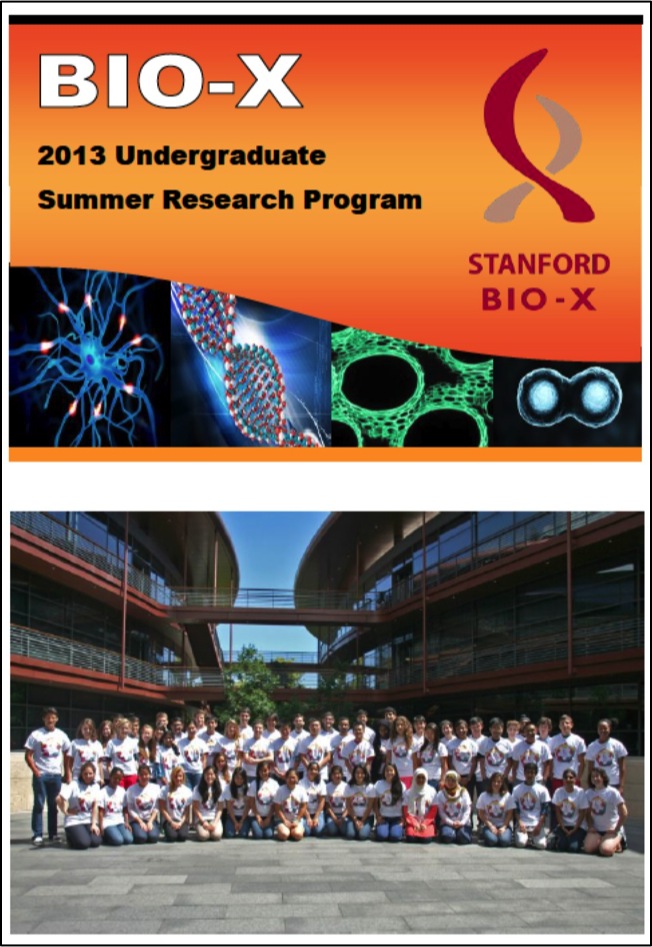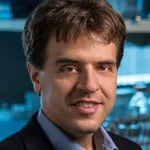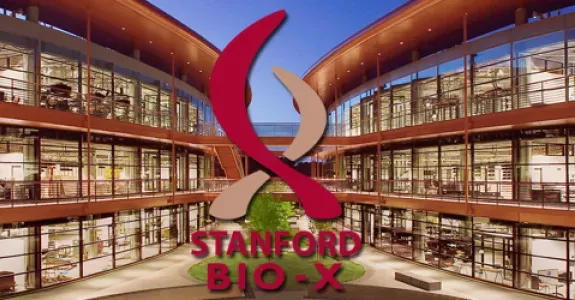
Welcome to the biweekly electronic newsletter from Stanford Bio-X for members of the Bio-X Corporate Forum. Please contact Dr. Hanwei Li, the Bio-X Corporate Forum Liaison if you would like to be added or removed from this distribution list, or if you have any questions about Stanford Bio-X or Stanford University.
Highlights
** On October 9, 2013, Bio-X celebrated the 10th Anniversary of the James H. Clark Center, the hub of Bio-X. Check out CLARK CENTER @ 10X as well as the Bio-X Timeline over the last 15 years!!
** Check out the article by Stanford President John Hennessy in the Nov/Dec 2013 issue of the Stanford Magazine on Bio-X and the Clark Center, "A Cauldron of Innovation".
Seed Grants
**UPDATE: BIO-X HAS JUST ANNOUNCED ITS 22 NEWLY AWARDED IIP SEED GRANT PROJECTS OF ROUND 7!! Click on the link to check out the project descriptions and read on to learn more about this round!
 SEED GRANTS FOR SUCCESS - Stanford Bio-X Interdisciplinary Initiatives Program (IIP)
SEED GRANTS FOR SUCCESS - Stanford Bio-X Interdisciplinary Initiatives Program (IIP)
The Bio-X Interdisciplinary Initiatives Program represents a key Stanford Initiative to address challenges in human health. The IIP awards approximately $3 million every other year in the form of two-year grants averaging about $150,000 each. From its inception in 2000 through the fifth round in 2010, the program has provided critical early-stage funding to 114 different interdisciplinary projects, involving collaborations from over 300 faculty members, and creating over 450 teams from five different Stanford schools. From just the first 5 rounds, the IIP awards have resulted in a 10-fold-plus return on investment, as well as hundreds of publications, dozens of patents filed, and most importantly, the acceleration of scientific discovery and innovation.
This year is the 7th round of the Bio-X IIP Seed Grants Program, and Bio-X has just announced it's 22 newly awarded projects selected from 142 Letters of Intent (LOIs)! This has been the largest number of LOIs that Bio-X has received. Please go here to check out the newly awarded projects. Competition was intense, and the selection criteria included innovation, high-reward, and new interdisciplinary collaborations. (To view the 142 other IIP projects that have been funded from the previous 6 rounds, please click here.)
We are cultivating and are highly successful in building meaningful collaborations with numerous corporate colleagues. New collaborations through our seed grant projects are highly encouraged. To learn about how to get involved, please contact Dr. Hanwei Li or Dr. Heideh Fattaey.
**On August 27, 2014, over 300 people attended Bio-X's latest Interdisciplinary Initiatives Seed Grants Program Symposium. There were 8 different oral presentations from faculty members who were awarded Bio-X Seed Grants on the progress that they have made with the funding towards their projects. In addition, Bio-X had its largest poster session ever with 167 posters presented during the reception of the symposium! If you'd like to learn more about any of the projects that were presented during the entire symposium, please contact Dr. Hanwei Li with your questions.
Fellowships
Every year, graduate students and postdoctoral scholars of Bio-X affiliated faculty are highly encouraged to apply for the Bio-X Fellowships, which are awarded to research projects that are interdisciplinary and utilize the technologies of different fields to solve different biological questions. Students are encouraged to work collaboratively with professors of different departments, thus creating cross-disciplinary relationships among the different Stanford schools. Our fellows have conducted exciting research, resulting in publications in high-impact journals and have been offered excellent positions in industry and academia.
To date, with the 19 new awardees of 2014, Stanford Bio-X has a total of 173 Fellows.
You can view the numerous Fellowship projects that have been awarded over the years as well as oral presentations from previous symposiums here.
 BIO-X UNDERGRADUATE SUMMER RESEARCH PROGRAM
BIO-X UNDERGRADUATE SUMMER RESEARCH PROGRAM
The Bio-X Undergraduate Summer Research Program supports undergraduate research training through an award designed to support interdisciplinary undergraduate summer research projects. The program is an invaluable opportunity for students to conduct hands-on research, learn how to carry out experiments in the laboratory, and develop the skills to read and analyze scientific literature. This program is eligible to Stanford students who want to work in the labs of Bio-X affiliated faculty.
To date, with 65 new awardees from 154 applications submitted this year, 306 students have been awarded the opportunity to participate in the Bio-X Undergraduate Summer Research Program.
Participating undergraduates are also required to present poster presentations on the research that they've conducted during the program. Please click here for title lists of past posters that our undergraduates have presented.
Many fruitful collaborations and relationships have been established with industry through fellowships. Please contact Dr. Hanwei Li or Dr. Heideh Fattaey if you'd like to learn more about how to get involved with these fellowship programs.
News
 Optogenetics earns Stanford professor Karl Deisseroth the Keio prize in medicine
Optogenetics earns Stanford professor Karl Deisseroth the Keio prize in medicine
Bio-X Affiliated Faculty Karl Deisseroth
Today optogenetics is a widely accepted technology for probing the inner workings of the brain, but a decade ago it was the source of some anxiety for then assistant professor of bioengineering Karl Deisseroth. Deisseroth had sunk most of the funds he'd been given to start his lab at Stanford into a crazy idea – that with a little help from proteins found in pond scum he could turn neurons on and off in living animals, using light. If it didn't work he'd be out of funds with no published research, and likely looking for a new job. Luckily, it worked, and has just earned Deisseroth, now the D. H. Chen Professor of bioengineering and of psychiatry and behavioral science, the 2014 Keio Medical Science Prize. Thousands of labs around the world are now using optogenetics to understand and develop treatments for diseases of the brain and mental health conditions and to better understand the complex wiring of our brains. ... Decades ago, when teams of scientists began studying the light-sensitive proteins within microbes it wasn't with an eye toward one day helping people with depression, Parkinson's disease or untreatable pain. It was to better understand the intricate and amazing world around us. The research was fueled by pure scientific curiosity. Curiosity that has, as it happens, led to a discovery that might just help people. Deisseroth argued in a Scientific American piece about the importance of funding curiosity-driven research as opposed to more targeted disease-focus research that some scientists and funding agencies have advocated. ... He argues that funding agencies need to not only support fundamental research, but also facilitate the translation of that basic research into the work that can one day help patients. "This is something that Bio-X does well," Deisseroth said. He works in the Clark Center that houses Bio-X, where scientists from very different backgrounds work elbow to elbow. "They put people who come from different perspectives within shouting distance of each other so those leaps can happen," he said. Bio-X has provided seed funding for a number of optogenetics collaborations and also supports the optogenetics core, where scientists can learn how to employ the technique in their own labs.
Stanford bioengineer among Popular Science magazine’s “Brilliant 10”
Bio-X Affiliated Faculty Manu Prakash
Manu Prakash, PhD, a prolific inventor of low-cost scientific tools, has been named one of Popular Science magazine’s “Brilliant 10” for 2014 – an award that recognizes the nation’s brightest young minds in science and engineering. In the last year Prakash has introduced two novel science tools made from everyday materials.The first was a fully functional paper microscope, which costs less than a dollar in materials, that can be used for diagnosing blood-borne diseases such as malaria, African sleeping sickness and Chagas. It can also be used by children — our future scientists — to explore and learn from the microscopic world. The second was a $5 programmable kid’s chemistry set, inspired by hand-crank music boxes. Like a music box, users crank a wheel that feeds a strip of hole-punched paper through the mechanism. When a pin hits a hole, it activates a pump that releases a precise, time-sequenced drop of a liquid onto a surface. This low-cost device can be used to test water quality, to provide affordable medical diagnostic tests, or to design chemistry experiments in schools.
 Stanford bioengineers develop a toolkit for designing more successful synthetic molecules
Stanford bioengineers develop a toolkit for designing more successful synthetic molecules
Bio-X Affiliated Faculty Christina Smolke
Ever since Robert Hooke first described cells in 1665, scientists have been trying to figure out what is going on inside. One of the most exciting modern techniques involves injecting cells with synthetic genetic molecules that can passively report on the cell's behavior, or even alter its function. A new computer model developed by Stanford engineers could not only improve the sensitivity and success of these synthetic molecules, but also make them easier to design in the first place. The work is detailed in the current issue of Nature Methods. Typically, scientists have built synthetic molecules through trial and error. This approach has allowed some interesting developments, said Christina Smolke, senior author on the paper and an associate professor of bioengineering at Stanford, but it inhibits forward engineering approaches, which ultimately limits the potential of the tool. "You start with an idea of what you want to do in the cell, and then you build and iterate on a design over and over until you reach something close to what you want," Smolke said. "As we design and build more sophisticated systems, we will want the ability to efficiently achieve precise quantitative behaviors, and being able to accurately predict relationships between the system inputs and outputs are important to achieving this goal."
UV light can turn gene into source of skin cancers, researchers find
Bio-X Affiliated Faculty Paul Khavari
A genetic mutation caused by ultraviolet light is likely the driving force behind millions of human skin cancers, according to researchers at the Stanford University School of Medicine. The mutation occurs in a gene called KNSTRN, which is involved in helping cells divide their DNA equally during cell division. Genes that cause cancer when mutated are known as oncogenes. Although KNSTRN hasn’t been previously implicated as a cause of human cancers, the research suggests it may be one of the most commonly mutated oncogenes in the world. “This previously unknown oncogene is activated by sunlight and drives the development of cutaneous squamous cell carcinomas,” said Paul Khavari, MD, PhD, the Carl J. Herzog Professor in Dermatology in the School of Medicine and chair of the Department of Dermatology. “Our research shows that skin cancers arise differently from other cancers, and that a single mutation can cause genomic catastrophe.” Cutaneous squamous cell carcinoma is the second most common cancer in humans. More than 1 million new cases are diagnosed globally each year. The researchers found that a particular region of KNSTRN is mutated in about 20 percent of cutaneous squamous cell carcinomas and in about 5 percent of melanomas. A paper describing the research was published online Sept. 7 in Nature Genetics. Khavari, who is also a member of the Stanford Cancer Institute and chief of the dermatology service at the Veterans Affairs Palo Alto Health Care System, is the senior author of the paper. Postdoctoral scholar Carolyn Lee, MD, PhD, is the lead author.
 Stanford scientists map white matter connections within the human brain
Stanford scientists map white matter connections within the human brain
Bio-X Affiliated Faculty Brian Wandell
To see, think or feel, the 100 billion neurons in our brain must exchange messages. These are transmitted over some 100 trillion specialized connections, known collectively as the "connectome." Most connections are extremely short, carrying information a few hundred-thousandths of an inch between nearby neurons. But many important connections are much longer, winding as much as a foot from one end of the brain to the other. Scientists at Stanford University have developed a mathematical and computational technology that allows researchers to more accurately map the large, long connections within the white matter tissue of living human brains. The methodology is called LiFE, for linear fascicle evaluation. The work is detailed online in Nature Methods.
Events
| Neurology and Neurosciences September 19, 2014, 8 am - 9 am LKSC Rm 130, Stanford, CA "Multiple Sclerosis/Neuromyelitis Optica" Speaker: Claudia Lucchinetti, Univ. of Rochester SOM |
Biology Sept 22, 2014, 4 pm - 5:30 pm Clark Center Auditorium, Stanford, CA "PARPs function as key regulators of protein and mRNA homeostasis" Speaker: Paul Chang, MIT/ Koch Institute |
| Cardiovascular Institute September 23, 2014, 12 pm - 1 pm LKSC Rm 120, Stanford, CA Frontiers in Cardiovascular Science: "Experiences in Drug Discovery" Speaker: P. Roy Vagelos, Retired Chairman & Chief Executive Officer of Merck & Co. Inc. |
Stanford Neurosciences Institute Oct 9-10, 2014 Mackenzie Room, Huang Engineering Building, Stanford, CA SNI Inaugural Symposium Speakers: Ann Arvin, John Rogers, Bruce Rosen, Corinna Darian-Smith, Thomas Insel, Carla Shatz, Karl Deisseroth, Nita Farahany, Thomas Südhof, John Hennessy, William Newsome |
Resources
| Stanford University |
| Stanford Bio-X |
| Bio-X Seed Grants The Stanford Bio-X Interdisciplinary Initiatives Program (IIP) provides seed funding for high-risk, high-reward, collaborative projects across the university, and have been highly successful in fostering transformative research. |
| Office of Technology and Licensing "Techfinder" Search the OTL Technology Portal to find technologies available for licensing from Stanford. |
| Stanford Center for Professional Development - Take advantage of your FREE membership! - Take online graduate courses in engineering, leadership and management, bioscience, and more. - Register for free webinars and seminars, and gets discounts on courses. |
| Stanford Biodesign Video Tutorials on how FDA approves medical devices A series of video briefs recently produced by the Stanford Biodesign Program teaches innovators how to get a medical device approved for use in the United States. This free, online library of 60 videos provides detailed information on the Food and Drug Administration regulatory process, short case studies and advice on interacting with the FDA. |
To learn more about Stanford Bio-X or Stanford University, please contact Dr. Hanwei Li, the Bio-X Corporate Forum Liaison, at 650-725-1523 or lhanwei1@stanford.edu, or Dr. Heideh Fattaey, the Executive Director of Bio-X Operations and Programs, at 650-799-1608 or hfattaey@stanford.edu


